Brewing the Best Coffee
With dozens of coffee brewing methods and machines on the market today, finding the best one for you can take some time and research. Sorting through the benefits and pitfalls is something you want to do before investing in a system, because the end results are not always obvious in the beginning.
Today we’ll look at brewing methods below $1,000 in up front investment. We’ll compare the cost of the machines and the cost to keep it running. Convenience and quality round out the criteria.
For comparison, I’ve chosen a widely available, solid performer in each class: semi-automatic, fully-automatic, espresso pod system, coffee pod system, and finally, the French press.
Let’s get started.
The Machines
Semi-Automatic Espresso Machine
Breville Barista Express Espresso Machine
$750
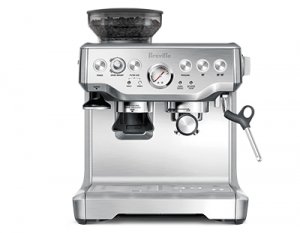 The Breville Barista Express semi-automatic is for the home brewer with dreams of being a barista who has some time to devote to a quality cup. This was built with a solid focus on espresso, and true to its Barista name, this model gives you hands-on control. You can adjust both. the grind and temperature of the brew.
The Breville Barista Express semi-automatic is for the home brewer with dreams of being a barista who has some time to devote to a quality cup. This was built with a solid focus on espresso, and true to its Barista name, this model gives you hands-on control. You can adjust both. the grind and temperature of the brew.
That control also requires more work on your part. The steel grinder preps the beans at the push of a button, but after that, you roll up your sleeves and get to work. The fresh grounds deposited in the Need to be tamped down before brewing. Milk foam relies on a steamer wand, so you get the full barista experience of shush shushing that milk into foam. The manual effort gives you more control, making it one of the best options for latte art.
The Barista requires a fair amount of clean up after every cup. The spent coffee gets compacted in the coffee filter basket and needs to be cleaned out after every pull.; it can take a bit of effort to get the stubborn, wet grounds free. The steamer wand also has to be cleaned after each use.
As for cost, it’s a decent price for a solid machine, and after the initial investment, costs less per cup than pod-based systems.
SUMMARY: This is a good machine for the person who is willing to invest a little time and effort for a quality cup of espresso and doesn’t mind the clean-up. It’s not the best option for someone rushing out the door in the morning.
Fully Automatic
Philips 4300 LatteGo
$899
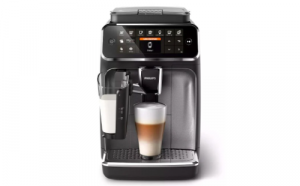 Philips offers a range of fully-automatic machines. The newest is the Philips 5400, and it’s close to being my dream machine. But, since it’s exclusive to Williams Sonoma in the United States, the machine weighs in right around the $1,000 limit with no pressure from competitors to encourage an occasional sale.
Philips offers a range of fully-automatic machines. The newest is the Philips 5400, and it’s close to being my dream machine. But, since it’s exclusive to Williams Sonoma in the United States, the machine weighs in right around the $1,000 limit with no pressure from competitors to encourage an occasional sale.
So for this review, we’ll look at the Philips 4300 – at around $900 it is a tad lighter on features and coffee drinks, but still a solid machine. It’s available through multiple retailers, so if the coffee gods smile on you, you may find a sale.
The Philips 4300 LatteGo does all of the work for you while still serving up a café-style drink customized to your preferences. There are eight pre-set formulas for coffee and espresso drinks including Cappuccino, Café au Lait, Americano, and other standards. If the presets aren’t to your tastes, you can customize and save your preferences. Other household members can save their own profiles, and there’s room for a guest setting, so Aunt Mary doesn’t accidentally reset your perfect brew.
Whole beans are stored in a hopper on top of the machine. A single-serve bypass filter lets you use pre-ground coffee if you want decaf or some other bean variety.
Coffee house beverages are created at the push of a button. When it’s espresso time, select your beverage from the digital menu and hit start. The 4300 grinds the beans, brews the espresso and adds the appropriate amount of steamed milk. That’s it – café coffee delivered in about three minutes.
Routine clean up is fairly easy. Spent coffee grounds form a puck that drops into a wastebin. The machine tells you when the bin wants to be emptied, and you clean the bin once a week. The frother system has an automated cleaning process. You’ll want to rinse out the brew group weekly and rmove coffee oils through an automated process once a month.
The 4300 costs more than the Breville semi-automatic in the same range, but the pay-off is convenience. Like the semi-automatic, after the initial investment, the 20 cent cost per shot is less than pod-based systems. The machine pays for itself in about a year when compared to pod-based systems.
SUMMARY: This machine is a great solution for someone who wants café-style espresso beverages in a hurry. Users can adjust the coffee grind, strength, temperature, and the amount of milk. Because the milk steamer is automatic , this is not the machine for latte art.
Pod-Based Espresso Machine
Nespresso CitiZ
$250
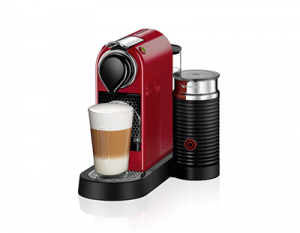 The sleek, Italian pod-based system that offers a wide variety of coffees and takes up minimal counter space.
The sleek, Italian pod-based system that offers a wide variety of coffees and takes up minimal counter space.
The Nespresso CitiZ is about as easy as it gets. You pop the pod into the top of the machine, close the handle, press the button – Voila – espresso in about a minute.
The Citiz doesn’t have a built in frothing option, but the company sells the Aeroccino for about $100. The stand-alone frother heats and froths the milk, but not with any precision, so you won’t be the Picasso of latte art. You can upgrade to a machine with a built in frother or frothing wand if you move into the $600 to $800 range.
Clean up doesn’t get much easier. Empty the spent pods from the bin every 12 shots or so, and decalcify the system a couple of times a year.
Nespresso’s official pods are of consistently high quality and can be purchased online or in Nespresso stores. The pods for either espresso or coffee come in varying intensities and offer more than 40 blends sourced from around the world. If you’re near a Nespresso boutique, you can drop in to sample the latest blend or drop off your spent pods for recycling.
If you’re not near a brick and mortar Nespresso, online ordering is easy and shipping is fast and reliable. If you keep an eye out, Nespresso online sometimes offers freebies like espresso cups or wooden trays with minimum orders. They’ll occasionally throw in a few free sample pods to introduce new variations.
A few independent companies are offering Nespresso style pods, but the reviews haven’t been great, and they cost as much as the real deal.
The Nespresso CitiZ requires minimal effort to produce some seriously good coffee with a beautiful, smooth crema. You pay for the convenience. While the machine itself is among the most affordable, each pod costs around 80 cents, making a single espresso shot about three times more expensive than systems that rely on coffee beans.
SUMMARY: A great machine that easily produces high-quality espresso. Ideal for people who value quality and convenience and aren’t concerned about cost.
Pod-Based Coffee Machine
Keurig K-Classic
$130
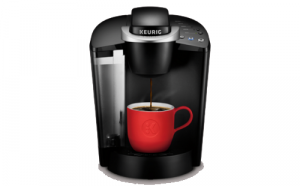 The Keurig is the familiar, approachable, pod-based system everyone has seen somewhere. Think of it as the vanilla of coffee makers – nothing exotic, but solid and reliable. Keurig has come up with a few variations on its basic machine, some with wi-fi; its mid-grade single-serve Keurig K-Classic will run you about $100.
The Keurig is the familiar, approachable, pod-based system everyone has seen somewhere. Think of it as the vanilla of coffee makers – nothing exotic, but solid and reliable. Keurig has come up with a few variations on its basic machine, some with wi-fi; its mid-grade single-serve Keurig K-Classic will run you about $100.
In addition to an affordable machine, the Keurig’s magic lies in its convenience. Pop in the pod, close the lid, hit start and you have a cup of coffee. Note that we’ve shifted to coffee here – not espresso. The Keurig does offer “espresso-style” pods, but the machine doesn’t reach the right pressure to brew espresso. Unlike some other brands, the Keurig can also brew tea and hot chocolate.
Keeping coffee pods on hand is also easy. The Keurig machine is so ubiquitous and got an early start in the market, so dozens of producers have packed their coffee into Keurig-compatible pods. You can find pods in the grocery store, big box store, or online. The quality isn’t as consistently high as the Nespresso pods, but the selection is wide. Competition affects price: pods can be had for as little as 50 cents a piece, while name brands like Starbucks and Illa charge about a dollar a pod.
Clean up is easy. Empty the bin when it gets full.
SUMMARY: Good basic joe for people on the go who want reasonably affordable convenience.
French press
No Name Brand Needed
$25
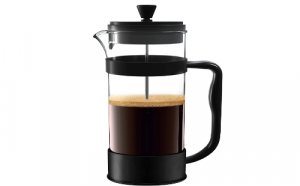 Ahhh the humble French press. It’s been around since………… and offers the cheapest option.
Ahhh the humble French press. It’s been around since………… and offers the cheapest option.
The press is a simple glass carafe with a filtered plunger system. Measure pre-ground coffee into the carafe, add hot water, let it steep. You have time to four minutes of something else here. Now plunge the filter to the bottom, and pour out your coffee.
You provide pre-ground coffee daily, so you can change your blend every day.
As simple as the process is, the French press is slow and messy. It takes three to four minutes to heat the water, another four to let it steep the grounds. By the time the coffee is ready, it’s lukewarm at best. If you’re a two-cup a day coffee drinker, you either have to repeat the time-consuming process or brew both cups at once and accept that the second cup will be cold.
Clean up can be a hassle as you fish out the grounds that are pressed into the bottom of the carafe for each cup or two of coffee.
If cost is your primary motivator, the French press is your solution. We’re not paying for brand names or high technology. An average press will run about $25, infinitely cheaper than any machine. You can use whatever ground coffee you like, so feel free to bargain hunt. Your cup of coffee can run as little as 20 cents a cup.
That said, you’re paying in other ways: clean up and cold coffee.
SUMMARY: A budget solution for patient people who like iced coffee or don’t mind microwaving for a hot drink. For many, the most affordable but least satisfying choice.
Conclusion
There is no one “best” method for brewing coffee. A number of variables have to be considered including up-front cost, day-to-day cost, convenience, and quality. Everyone’s priorities are different.
That said, for most serious coffee drinkers, I’d recommend the Philips 4300 for its overall balance between cost, convenience, and quality. Compared to pod-based systems, it costs significantly more up front, but becomes one of the cheapest options within a year. The quality of the frothing system meets most needs, and the source coffee quality is entirely up to you. The 4300 produces eight different cafe espresso drinks at the push of a button, making it convenient both for brewing and for cleanup. For its overall performance, the 4300 checks a lot of boxes.
Let me know which machine you chose.
